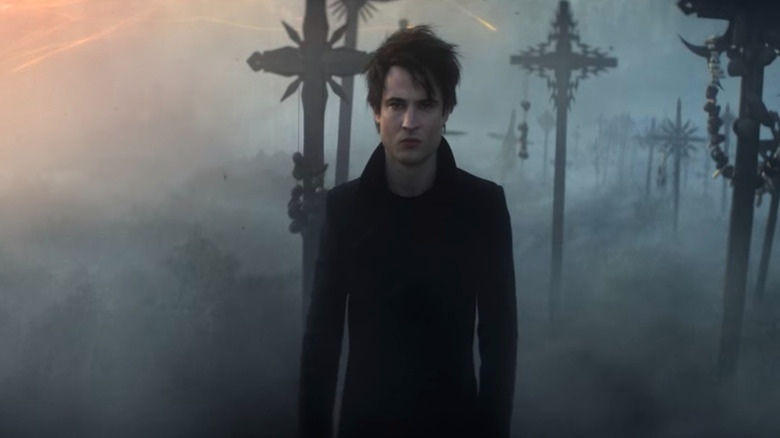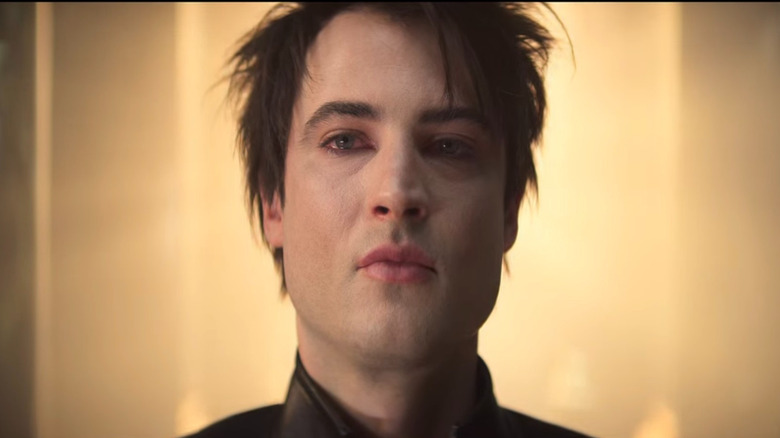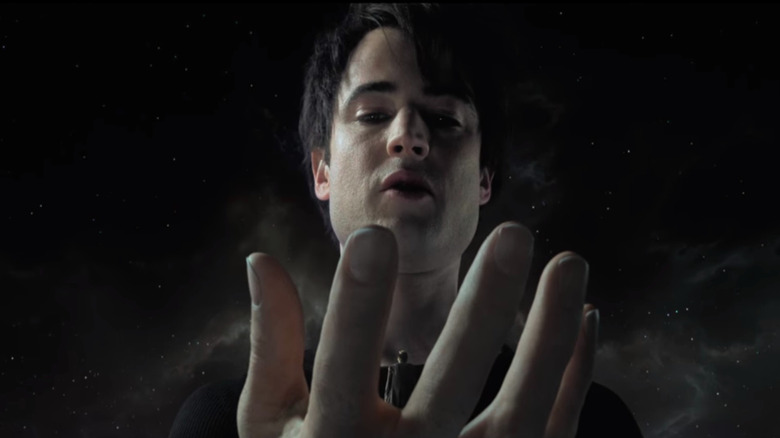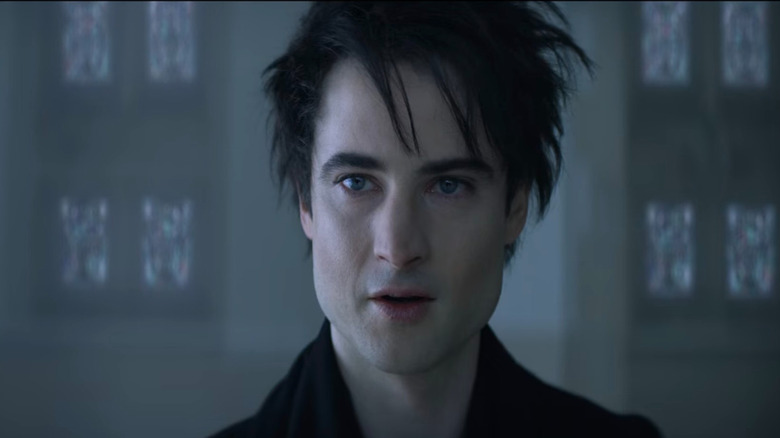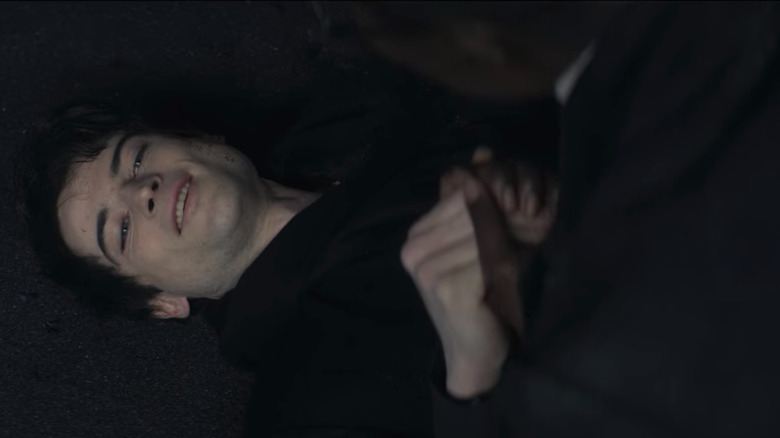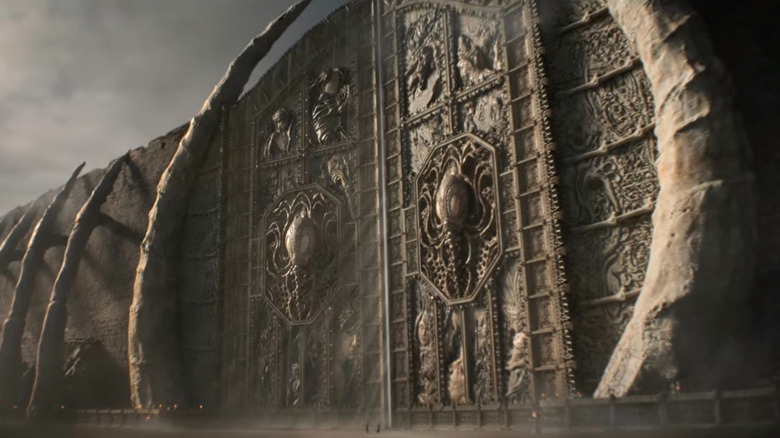Here's Why The Dreaming In The Sandman Sounds So Otherworldly
When "The Sandman" recently premiered on Netflix, audiences excitedly drifted off into the wacky world of The Dreaming. Based on Neil Gaiman's comic book of the same name, the series focuses on Lord Morpheus, an ancient being who oversees the realm of dreams and nightmares, and the supernatural creatures that live there. When the lord of dreams is kidnapped by a greedy human, his subjects escape The Dreaming and infiltrate the real world, which disrupts the boundary between dreams and reality.
The series provides loads of creepy visuals including a fair-haired Lucifer, an emaciated dream addict, and an entire convention of demented serial killers. There is no doubt that "The Sandman" provides audiences with a satisfying visual feast, but that does not mean that it neglects their ears. Series composer, David Buckley, spoke to Jack Giroux about creating the ethereal chimes, optimistic strings, and guttural bass tones of The Dreaming, and how he uses these sounds to communicate with the audience.
The auditory story
The visual language of movies is a widely researched aspect of filmmaking and is often the most discussed aspect of films among audiences. Modern audiences have a refined understanding of the language of moving images, and speak it fluently. The use of cuts, fades, two shots, close-ups, long takes, etc., all have an effect on the way audiences understand and interpret movies and shows, and the ability to use them to flawlessly communicate a message or theme is what makes someone a good filmmaker.
The ability to speak the visual language of film is just as crucial for viewers, who have to take moving images and interpret them in a way that culminates in a story. The interpretation of moving images comes second nature to modern audiences, who grew up watching TV and movies so much that analyzing them has become second nature. Along with the ability to analyze, interpret, and understand moving images, today's audiences have a refined ear for storytelling.
Filmmaking is generally classified as a visual art, and many would find that to be an accurate description for it, but sound has always been an important aspect of film. In the earliest stages of the art form, back in the silent film days, scores were written and performed by full orchestras as part of the movie's showing. Back then, music was used to make silent films more captivating, and to drown out the incessant clicking of the projector. To fully understand and relate to moving images, audiences' ears have always partnered with their eyes, and "The Sandman" offers yet another opportunity for this.
'A collaborative experience'
In his conversation with Giroux, series composer, David Buckley, spoke of relying on modern audiences' auditory intelligence with his scores for "The Sandman":
"My philosophy in general is — and I have to be careful when I say this, because it might make it sound as if I'm lazy or something — but I like the audience to work a little bit, in the process ... this isn't about not wanting to commit or not knowing what I'm doing. It really is a case of, I think that this is a collaborative experience with score. The audience, if you just help them to go in a certain direction, then they can take it to where they want to take it."
As he discussed, Buckley's themes in the series do not take hold of viewers and shove them towards a certain emotion. Instead, they take hold of their hands and gently nudge them towards the correct path. The composer's music accompanies many intense scenes throughout the series, and conjures feelings of fear, anticipation, triumph, and despair that perfectly complement the images on screen.
'The Kingdom of Dreams'
The main theme of The Sandman begins with eerie chimes that sound like something straight out of a psychological horror film. Buckley produced this ethereal sound with a 16th-century instrument called a Celeste, which looks a lot like a typical piano with a keyboard, but has internal chime boxes instead of strings. So, when the keys are pressed, chiming sounds are produced. Typically, this results in upbeat, whimsical tunes, but Buckley put a creepy spin on the original sound:
"And the sound of The Dreaming is a type of orchestral called a celeste, but I pitch shift it. I bend the sound, which is physically impossible to play. You literally cannot do that. But with sound processing manipulation, you can do it."
The bending of the sound turns a sweet, jaunty tune into the creepy ringing we hear at the beginning of the main theme over the credits in the series. These solitary, eerie chimes are soon joined by a steady, underlying drum beat, before being taken over by rising strings, and it all comes to a close with a deep, imposing, guttural bass. All of these sounds work together to communicate the many complicated layers of Morpheus. The creepy chimes signify his immortal, otherworldly nature, while the rising strings hint at a heroic quality underneath his black clothes and permanent scowl, and the harsh bass is used to communicate Morpheus' innate ability to rule over and punish those who get out of line.
This theme focuses on the aspects of a character, and helps viewers understand the different facets of Morpheus' complex personality. Additionally, a lot of Buckley's work is used to heighten the emotions surrounding certain scenes and events.
Dream's escape
When Morpheus returns to The Dreaming after being held captive for a century, Buckley's themes enhance emotions in the scene. Lucienne finds Morpheus face down on a beach, and runs over to him. Gentle strings and a soft, fluttering beat accompany the image of Morpheus smiling at Lucienne, realizing he's finally made it back to his realm after over a hundred years in captivity. He whispers her name, takes her hand, and she confirms, "You're home." A triumphant crescendo of the string instruments and ethereal vocals accompanies the two of them standing up and walking together. Morpheus' return is a moment of elation and relief for Morpheus and Lucienne, and that is reflected in the victorious sound of the music. However, the success is quickly undercut by harsh reality.
Morpheus and Lucienne make their way to the massive gates of The Dreaming, where the vocals, thumping drums, and string instruments heighten the awe viewers feel at the sight of the huge, ivory gate with hand-carved images of people, animals, and intricate designs. The audience feels the success of the moment. Morpheus has finally arrived home, back where he belongs, and he can rescue the world from escaped nightmares. However, the elation and relief quickly comes to an end.
When the gate opens, the triumphant music ends with a deep, growling bass. Morpheus turns to Lucienne, who confirms what the music hinted at, "The realm, the palace, they are not as you left them." There was an immediate shift in emotions from triumph and relief to anxiety and despair before any of the characters spoke because of the sudden shift in the music.
The scene ends with one more devastating bass tone as Morpheus comes face to face with his dilapidated realm.
Hearing and feeling emotions
Today, because of constant exposure to films and TV, audiences are more than capable of successfully analyzing moving images without sound. If "The Sandman" were totally silent, modern viewers would still understand the relief Morpheus feels when he lays eyes on Lucienne and the utter despair he endures when he sees the destruction of his realm. However, Buckley's themes take the understanding a step further and conjure those feelings of success, elation, and despair within the audience. Identifying with character's emotions brings audiences deeper into the story, and makes characters more relatable. By adding complex music to Morpheus' experiences, audiences have a deeper connection to Morpheus, his world, and his feelings.
"The Sandman" is full of visually enthralling images of dreams and nightmares, and Buckley's themes assure that you feel every victory, failure, and hope they represent.
